HUBERT de WATRIGANT I: Les Haras Nationaux 1989
BIOGRAPHY:
Hubert de Watrigant was born in 1954 and brought up in South West France where his father bred and trained racehorses. He inherited natural artistic talent from his maternal great grandmother, a landscape artist in the nineteenth century, and his paternal great uncle.
The de Watrigant family had an inbred passion for horses and it was natural, therefore, that his artistic career should begin by sketching horses in his father's stables. At school he drew ceaselessly in the margins of his sketchbooks.
On leaving school he joined the Army to serve his year of National Service. He then moved to Paris and began to earn a living through various different jobs, although he continued to draw and paint in his spare time, enabling him to exhibit in various small shows. In 1976 de Watrigant decided to become a full-time professional artist, holding his first one-man exhibition at Maisons-Lafitte. In 1977 he entered Les Sept Collines de Rome exhibition. He won first prize.
De Watrigant uses a wide range of materials including charcoal, pastels, watercolour and oils and works on many different surfaces. His draughtsmanship is outstanding and he has a remarkable ability to capture both the ambience of his subjects and the drama of a fleeting moment.
Influences on de Watrigant's work include Delacroix, Géricault, and principally, René Princeteau, the first teacher of Toulouse-Lautrec, who de Watrigant admires for his fine draughtsmanship.
His career was helped at the start by his family contacts in the racing world, but the quality of his work was such that he soon became recognized as one of France's leading equestrian artists. As testament to his talent his work now features in numerous private and public collections in England, Japan and the Emirates. Private collectors include Her Majesty The Queen, as well as many of the leading connoisseurs of equestrian art, including Baron Guy de Rothschild, the late Stavros Niarchos and the late Daniel Wildenstein. In America he has been commissioned by a number of stud farms including Spendthrift Farm, Gainesway and Calumet.
WATRIGANT FOR HERMÈS:
Les Haras Nationaux 1989, photo credit: Pauillac
Hubert de Watrigant has worked for Hermès on a regular basis since 1989 and is one of its iconic illustrators, the chairman of the French company, Jean-Louis Dumas talked about his experience with the artist and his work this way:
“Some people lighten us. Their Talents open up your eye, carry you away, deprive you from with delicacy of your everyday inhibition mask and reduce your anesthesia. For several years, I have had the privilege to observe Hubert de Watrigant moving forward in the free but rocky way of artists and illustrators. Guided by instinct, he has trusted his stroke, has merged into his spontaneous watercolors. He based his work on Horses, Hunt dogs and especially on Bulls and on those who, in the bullfight, dance to death with them.
Confronting his search for truthfulness in the harmony of life to the shock of emotions that bullfighting leads him to, he drew from his clever and graceful hand the strength to create series of amazing and engaging pictures. . The carrés that were born from his collaboration with our firm honor Hermes’ label and give it a supplement of elegance"
During so many years of collaboration, Watrigant has designed several scarves for La Maison, here you are a complete list of his works that I'll be presenting in the next weeks:
Les Haras Nationaux 1989
Carnaval de Venise (Fetes Venitiennes) 1993
Plaza de Toros 1993
Le Poitevin 1993
Real Escuela Andaluza del Arte Ecuestre 1996
Feria de Sevilla 1996
Ombrelles et Parapluies 1998
Musee Vivant du Cheval 2002
Un Siecle de Courses a Deauville 2003
Dans les Branches del’Ombu 2005
Lujo Criollo 2005
Croquis Champs de Courses 2007
Ballet Equestre 2007
Les Chevaux Quataries 2008
Les Poneys de Polo 2010
Hubert de Watrigant is basically an equestrian artist, his work has been exhibited in many galleries around the globe and his pictures are very coveted by equestrian art collectors:
As a horse painter, he has designed several of the most beautiful Hermès scarves based on equestrian theme. Les Haras Nationaux is the first profile I'd like to present, thank you very much to dear Pauillac who lend me her pictures:
LES HARAS NATIONAUX
Hubert de Watrigant
First Issue: 1989
Catalogued: 4C
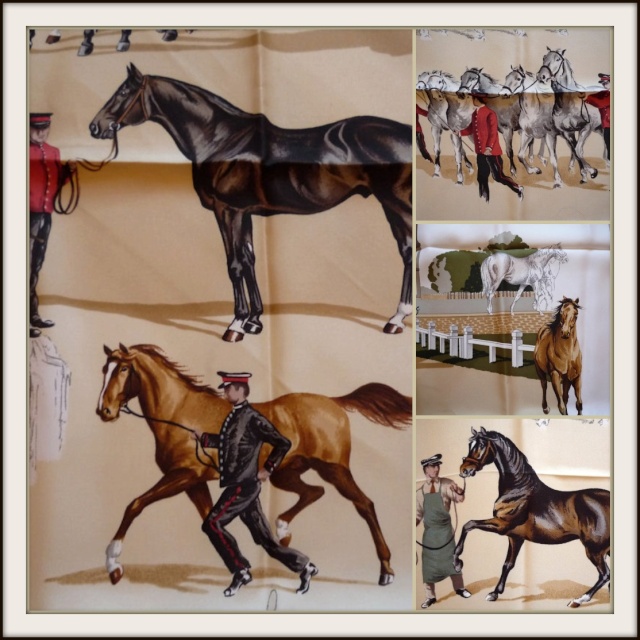
Next week, I am presenting a new profile: Carnaval de Venise (Fetes Venitiennes) 1993, by the same author, feel free to email me any pictures of this scarf you would like me to post.
*****************************************
HUBERT DE WATRIGANT II. Le Carnaval de Venise 1993/Fetes Venitiennes 1999
January is practically over and Carnaval is coming!
Carnevale, also known as carnival or mardi gras, is celebrated in Italy and many places around the world 40 days before Easter, a final party before Ash Wednesday and Lent. Could it be a better time to review this scarf?
LE CARNAVAL DE VENISE 1993 / FETES VENITIENNES 1999
Hubert de Watrigant
Jacquard silk
Catalogued: 4C/4D
Both scarves share the same design by Hubert de Watrigan on Jacquard Silk, the first of them, Le Carnaval de Venise is from 1993 while the second one, Fetes Venitiennes was issued in 1999, dear Lilyhermes told me that The Carnevale Comitee of Venice threatened to sue Hermès for the use of the name "Le Carnaval de Venise", forcing them to change the name of the scarf to "Fetes Venitiennes".
This is one of the most colorful Hermes scarves and features a great number of color screens, its vibrant harmony makes it extremely attractive.
At the center, the design features a group of passerbyes dressed in period finery admiring a lovely view of San Marco Basilica and Campanile, both in Piazza San Marco, around this beautiful settecento scene, there are groups of people dressed in carnaval costumes, typically inspired in La Commedia dell'Arte masks: Arlecchino, Bauta, Capitano, Brigella, Pulcinella... see La Comedie Italienne if you want to learn more about it.

The scarf is a masterpiece of geometry and use of color. It is divided in four main rhombus squares whose background color is repeated in the adjoining triangle to the left forming a stunning game of clever dynamism. Geometry is also present in the Venetian mooring poles and the gothic Venetian window at the center (Thank you dear Bonnie for your contribution):

Photo credit: Bonnie
The details of the characters are also amazing, the delicacy of the gestures and the clothes reminds me of the best vintages by Ledoux:
Le Carnaval de Venise and Fetes Venitiannes, has been produced in a wide array of colors always with contrast hems and beautiful combinations, thank you ScarfAddict for lending me your pictures:
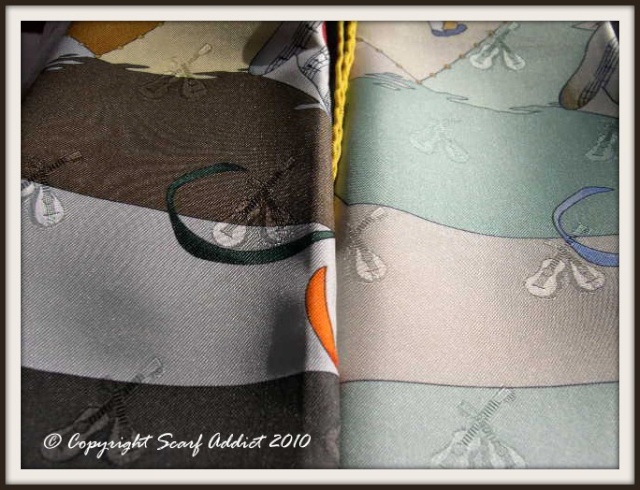

I hope you have enjoyed this review. Next week, I intend to go on with Hubert de Watrigant part III featuring a special issue on Spanish themed scarves: Plaza de Toros, Feria de Sevilla and Real Escuela Andaluza del Arte Ecuestre, so we'll back to equestrian themes! Ci vediamo allora!
*****************************************
HUBERT DE WATRIGANT III: PLAZA DE TOROS 1993
First Issue: 1993
Catalogued: 3B
Not only is Hubert de Watrigant a brilliant equestrian painter but he is also a connoisseur of the world of tauromaquia, the art related to bulls and bullfighting as we can see in many of his paintings:
In Plaza de Toros he depicts the traditional elements of a classical Corrida de Toros. The scarf is designed around a broad circle which represents the bullring (La Plaza). In the very center we can see the entourage of authorities (alguaciles) who officially open the corrida, the montera (matador's hat) two pairs of banderillas and a Matador jacket (la chaquetilla).
This is the main piece of the Traje de Luces (Suit of Lights) called so for the reflections produced by the thousands of hand embroidered sequins and gold thread. A suit of lights can cost over 4000 Euros and some of the best known toreros wear it only once. Until the 18th century it was made of suede but since then is made of silk and adorned with gold for the matadors and silver for the banderilleros, the hat called montera, is made of astrakhan and lined in taffeta. This is a detail picture of the back of a chaquetilla:
Since the Traje de Luces is entirely hand made by accomplished artisans, it's not wonder that it inspired fashion designers like Galliano, Dior, Gaultier, Lacroix, etc:
Bullfighting and art have always walked hand in hand. The visual intensity of bullfighting has greatly fascinated plastic artist like Goya, Picasso, Dalí or Miró:
Several contemporary photographers have also gotten inspiration from bullfighting, like the French photographer Josephine Douet in her wonderful series on the handsome Spanish matador José María Manzanares:
Back to the silk, we can see other characters depicted on the scarf, like the Mozo de Mulas, Picador and Rejoneador (shown in the next pictures). Around the central motive, there are toreros performing different pases, meaning different figures of bullfighting art: Verónica, Pase de Pecho, Natural, etc. In the corners we can find four alamares, traditional decorations on a classic Traje de Luces.
Although it's the most popular, Plaza de Toros is not the only Hermès scarf inspired by bullfighting, Toros, by Hugo Grygkar is its predecessor from 1952, this scarf is a real rarity, I'll post more pictures of it in my future review on "The rarest Hermès scarves"
Although bullfighting is a sensitive issue for many people, it's also unquestionable that it has drawn the attention of several celebrities from the world of art, like Ernest Hemingway, Grace Kelly, Ava Gardner, Greta Garbo, Charlton Heston, Orson Welles, Mario Vargas Llosa, Mme and M. Sarkozy, etc.
Let's say hasta luego by now with a display of different color ways of this beautiful H. de Watrigant's design:
*********************************************
HUBERT DE WATRIGANT IV: DANS LES BRANCHES DEL'OMBÚ
HUBERT DE WATRIGANT: DANS LES BRANCHES DEL'OMBÚ
Hubert de Watrigant
First issued: 2005
This could be one of my latest posts from Argentina, my adoptive country for more than fourteen years. As some of you already know, I'm moving back to Europe after Christmas (Yes, back home!) May this entry be a tribute to this country, its culture and folklore embodied in the figure of the gaucho.
As usual, Hubert de Watrigant made an incredible research on the theme chosen for the design, which shows great knowledge of the gaucho culture. (See more about Watrigant's work and biography here: Hubert de Watrigant)
At the center of the scarf there is a silhouette of an Ombú tree which gives the title to the scarf, Under the Branches of the Ombú. This tree is very common in Argentina, actually they are very popular spots in Buenos Aires for the visitors to take pictures of their impressive trunks:
The ombú has an umbrella-like canopy that spreads to a girth of 12 to 15 meters (40 to 50 feet) and can attain a height of 12 to 18 meters (40 to 60 feet), it's considered a symbol for the gaucho culture.
The scarf is framed by four patterned ribbons, called guarda pampa, lovely interwoven at the corners. The guardas pampa are handwoven textiles used originally by the Mapuche indians to indicate hierarchy in a similar way to the Scottish kilts:
Hubert de Watrigant masters the art of drawing horses and his love for country life can be noticed in many of his designs, in this particular scarf he has perfectly combined both passions presenting an impressive array of gaucho features. The title of the scarf conveys the message of people resting and enjoying life after a lot of hard work driving herd throughout the pampas.
Gauchos are extremely proud of what they call lujos criollos (freely translated as Creole luxuries or fineries) which include different items such as boleadoras, estribos, chifles, tiradores, rastras, mates, ponchos, espuelas and quite a lot of others. Watrigant has brilliantly depicted most of them in this design.
In this scene we can see two gauchos at full gallop waving boleadoras. Traditionally, they are primitive hunting tools made of cow leather but as many other gaucho items, they have also become pieces of art made of noble materials.
One of the most characteristics rituals of the gauchos is drinking mate:
Mate is prepared from steeping dried leaves of yerba mate in hot water, it is served with a metal straw (bombilla) from a shared hollow calabash gourd (mate). The gourd can also be made of different materials, silver for the gaucho finery.
Mate is traditionally drunk in a particular social setting, such as family gatherings or with friends. The same gourd (mate) and straw (bomba/bombilla) are used by everyone drinking. It is hard for a foreigner to become a mate drinker, but if you share mate with friends regularly it will soon be a part of your social life in Argentina.
This is a charming scene of a guitarreada. Gauchos are well known for their musical parties and traditional folklore. If you pay attention to the scene, you can see several key parts of the gaucho attire, such as the tiradores (wide leather sash covered with coins or other pieces of silver), fastened with rastras (big silver clasps) that hold the cuchillo o facón (knife):
The guitarreadas are usually held in the open after a good asado (barbecue), in these parties, the gauchos play traditional instruments and recite old poems.

It's impossible to imagine a gaucho without his poncho. Ponchos are handwoven pieces of llama or alpaca wool usually worn as a cape, but they can also be used as blankets for the freezing nights out in the open in La Pampa.
In addition to the poncho, this scene shows some important parts of the horse equipment such as headstall, stirrups, reins, blanket, etc.
Nowadays antique ponchos are extremely valuable pieces, they are very sought after for interior decoration. The ponchos worn by women (usually opened at the front) are called ruanas.
Another typical activity of the gauchos is the jineteada, they are equestrian shows performing horse races and skill games:
I have borrowed the last picture from dear Sachiko from Greenjade who kindly allowed me to use it to illustrate the title of the scarf with a very different, more subtle color way.
The piece near the title is a chifle, a big cow horn used to transport liquids, especially brandy.
Another interesting detail of this part of the scarf is the ribbon displaying a thistle flower, the
flor de cardo, is the national flower of Argentina.
Dans les Branches del'Ombú is not the only Argentinian themed Hermès scarf, to the best of my knowledge there are some others:
Gaucho by Cathy Latham 1978
Gaucho (pochette) by J.Metz date unknown
Pampa by Jean de Fougerolle 1988
Argentine Diaguita et Guaraní by J.Y Merthier 1966
I'm saying goodbye for the time being
Under the Branches of the Ombú in my yard.
Many thanks to the manager of Cardon who kindly allowed me to take pictures in his beautiful store in Avenida Alvear 1841 in Buenos Aires.
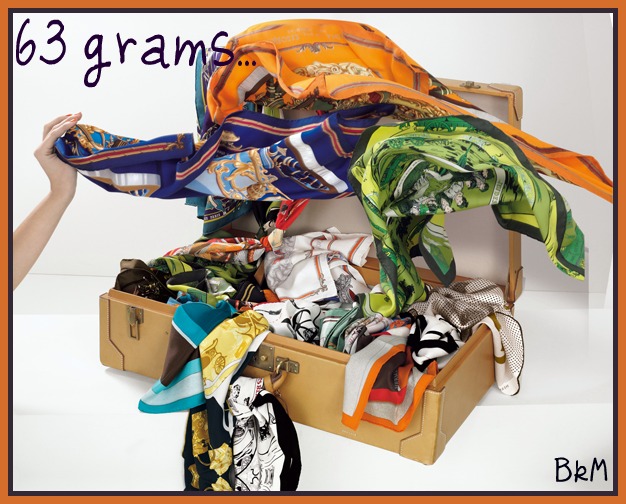
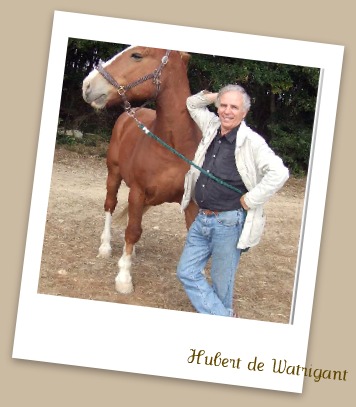
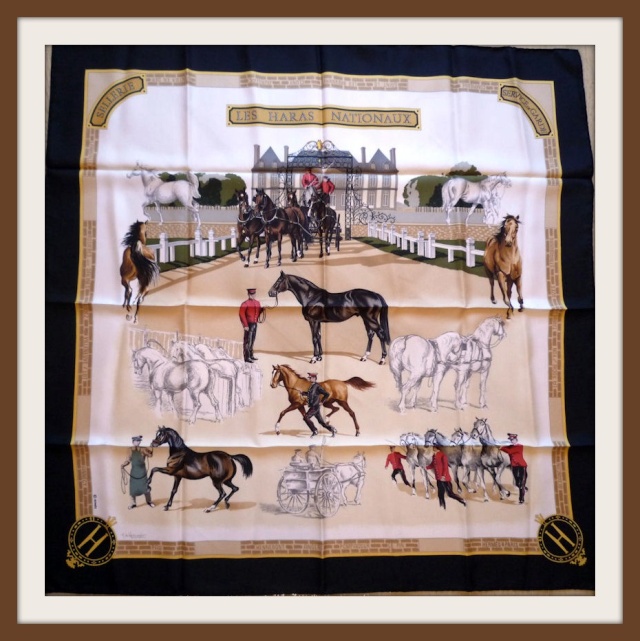
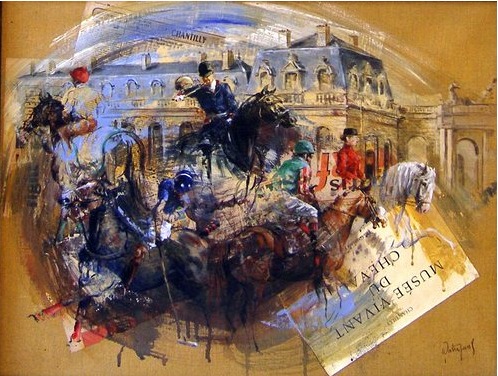


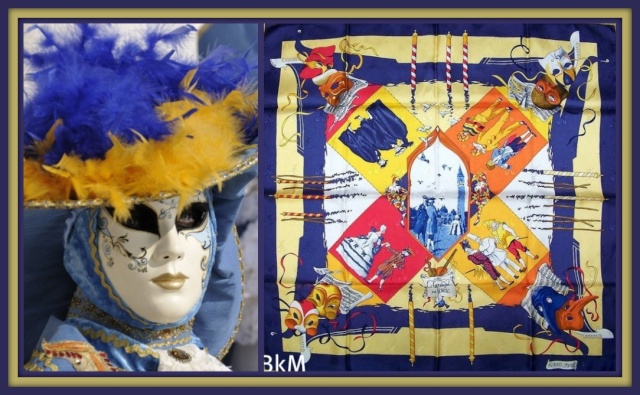






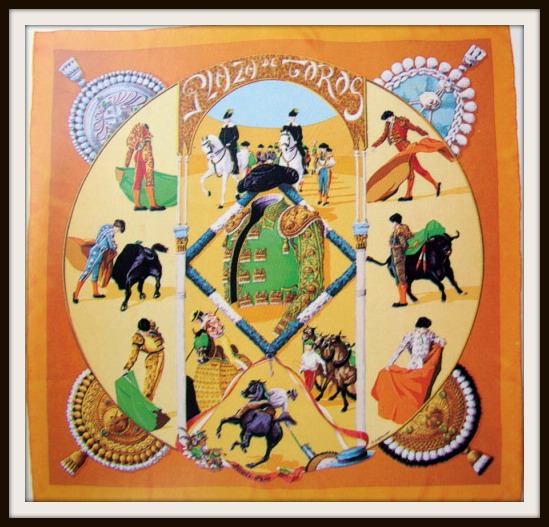
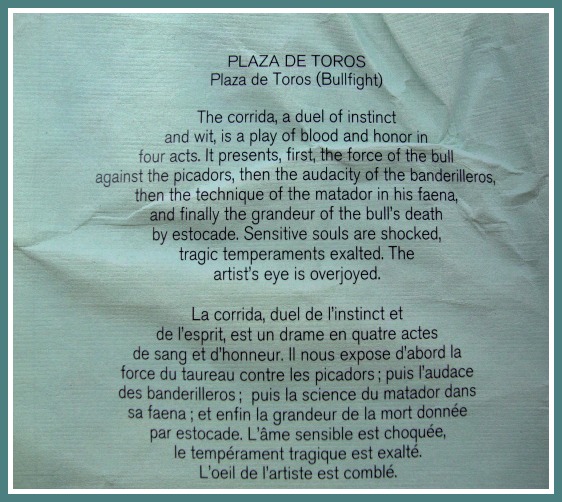
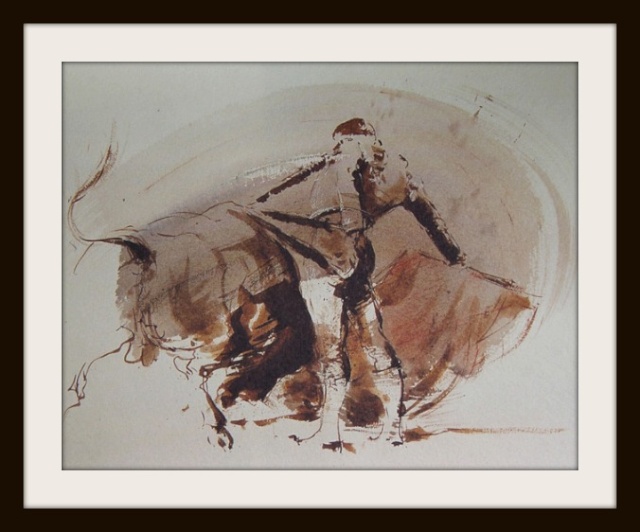
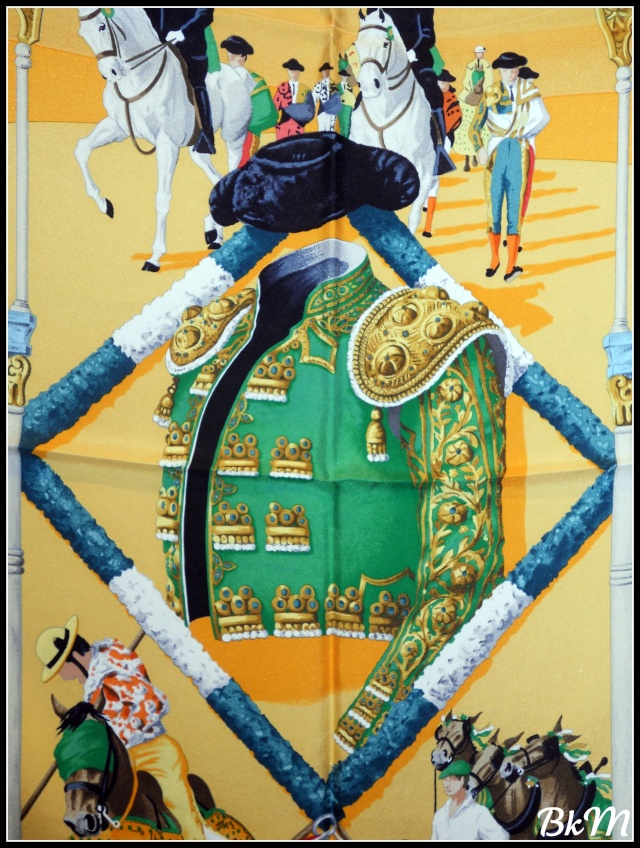
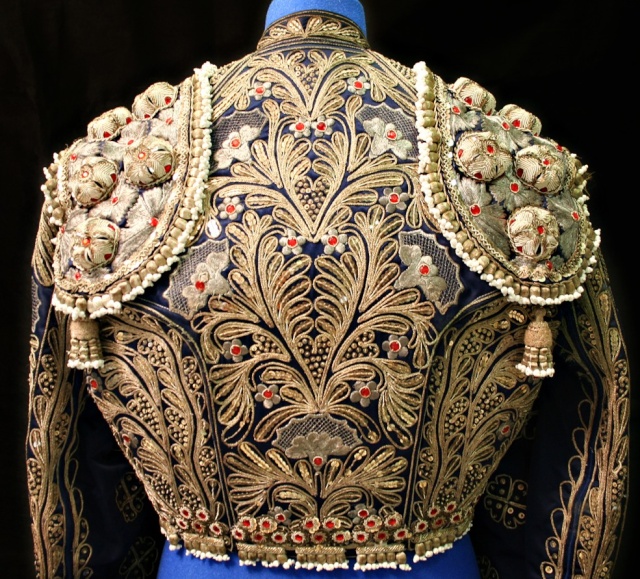
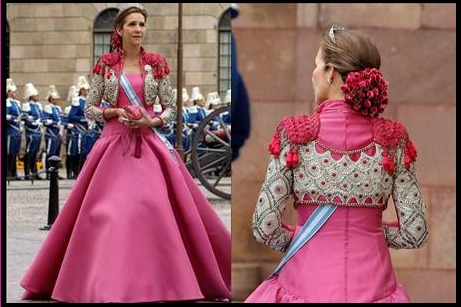
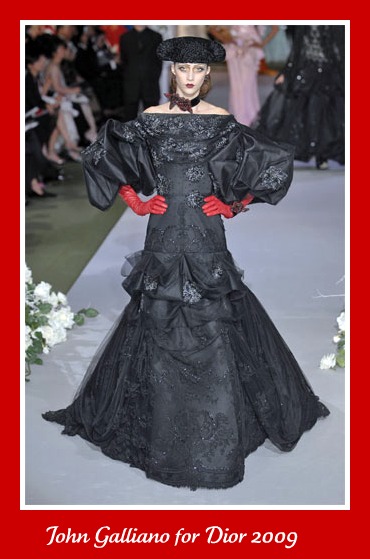
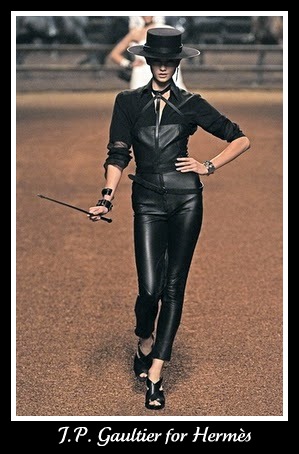
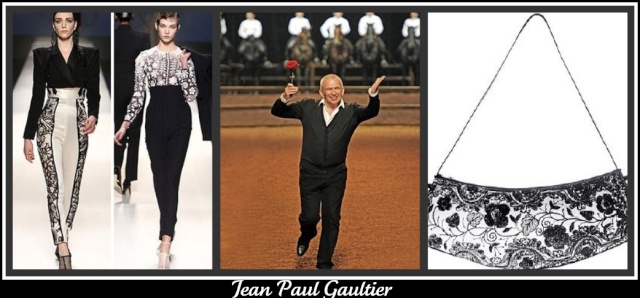


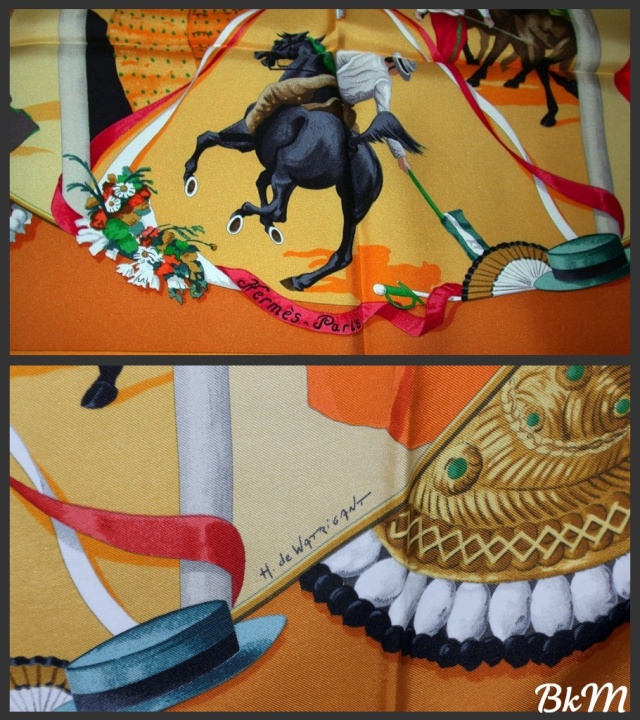
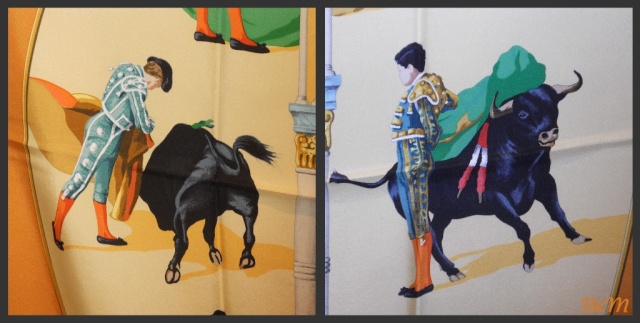
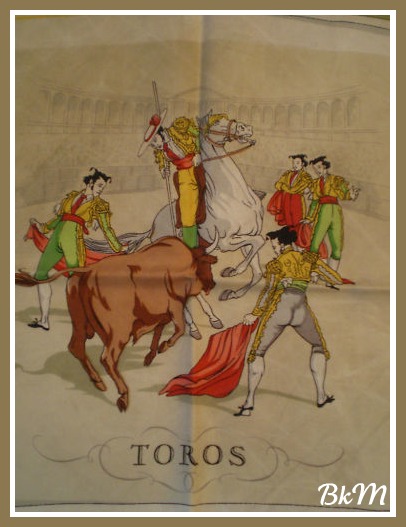
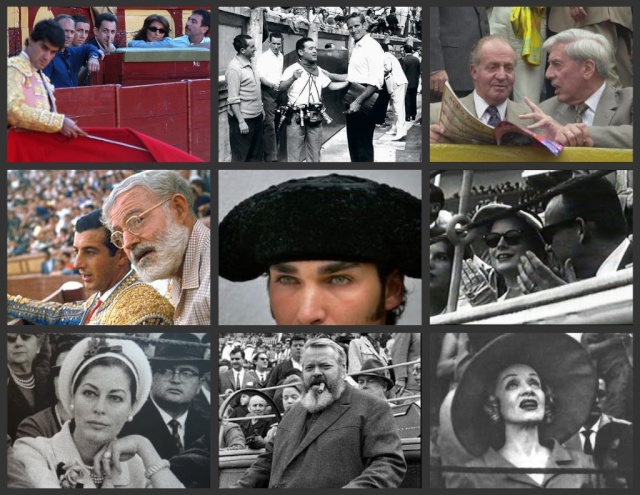
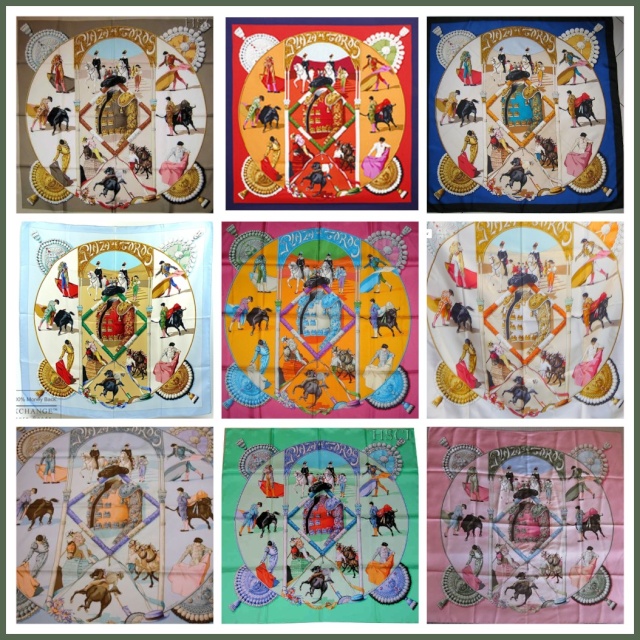



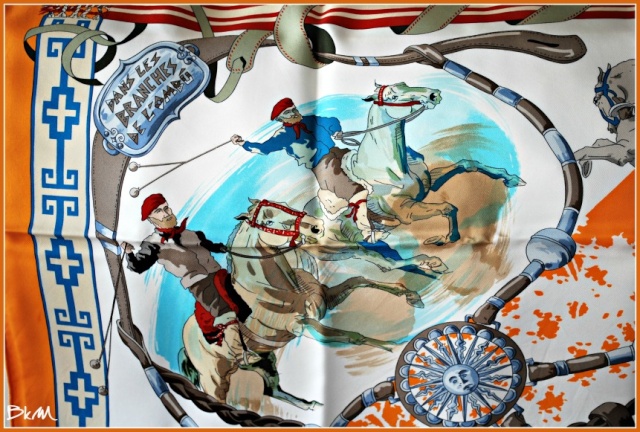
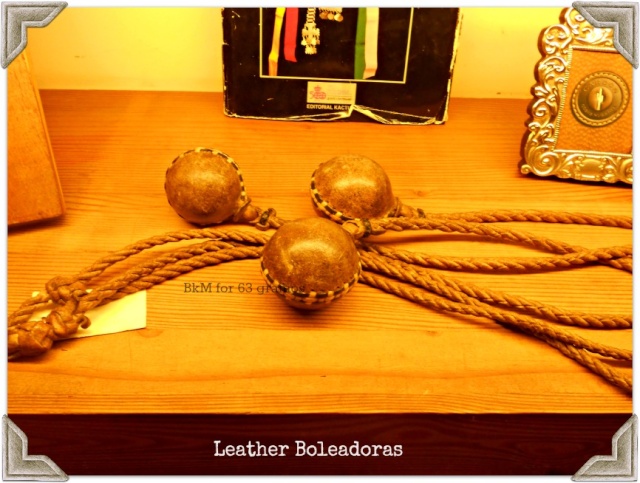
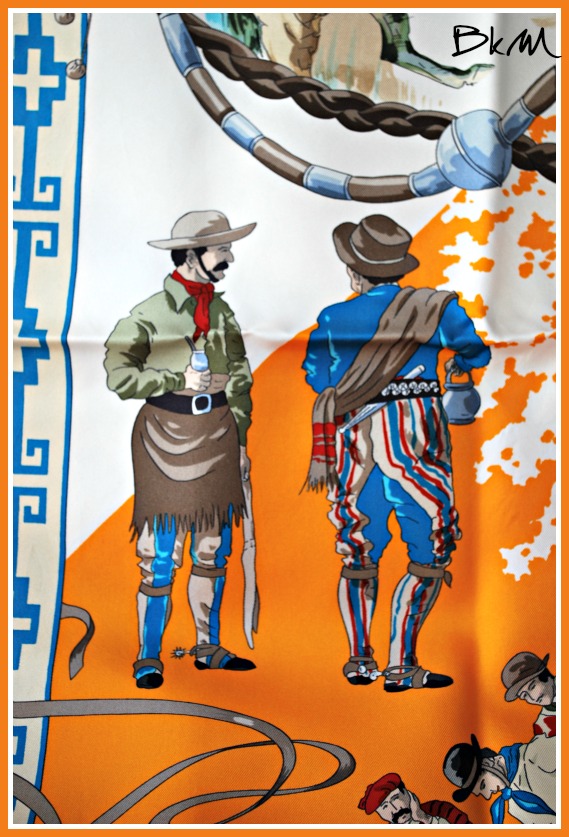
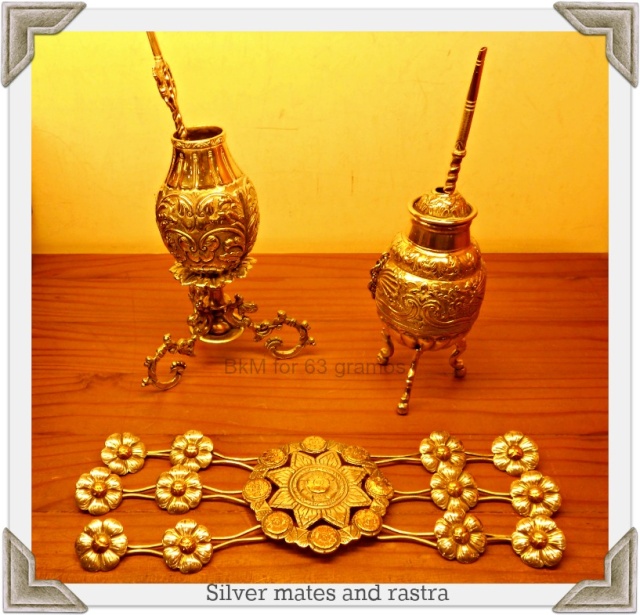
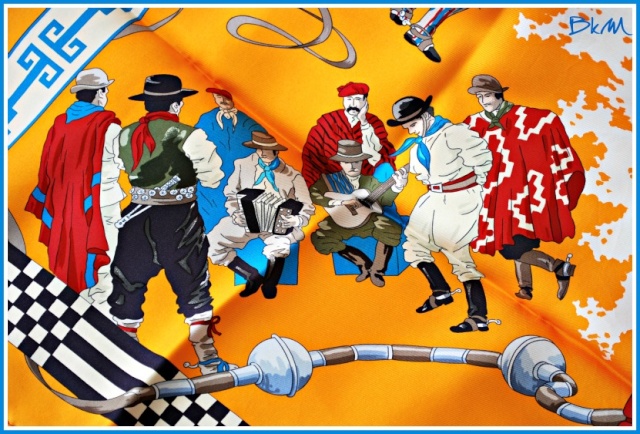
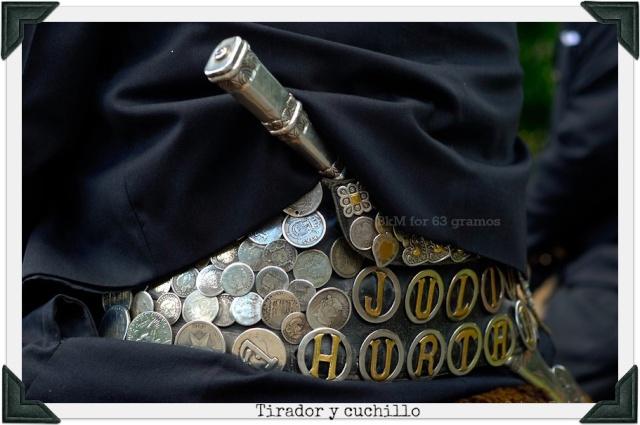




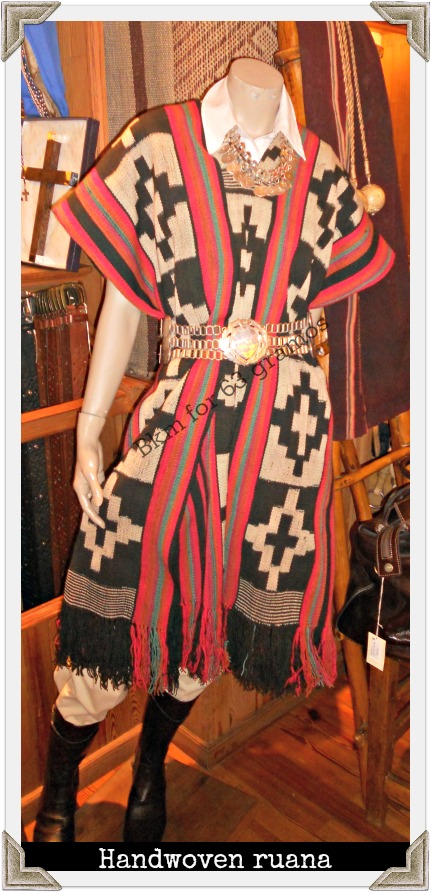
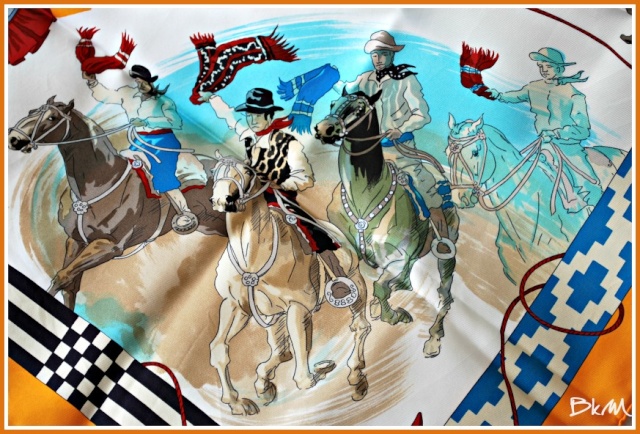

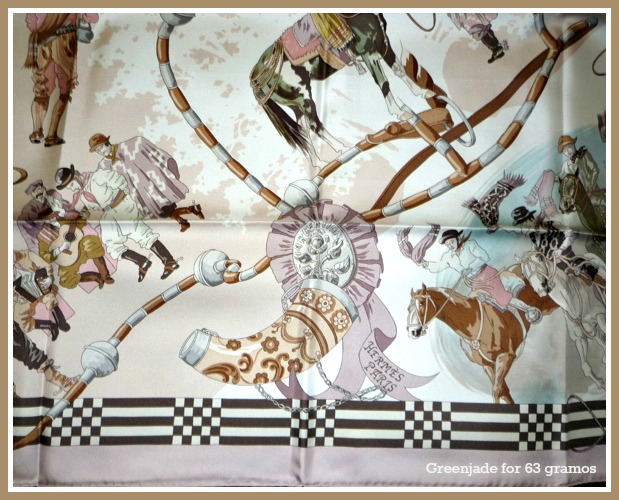


No comments:
Post a Comment
Note: Only a member of this blog may post a comment.